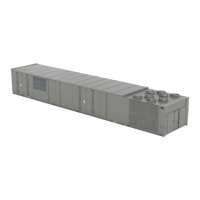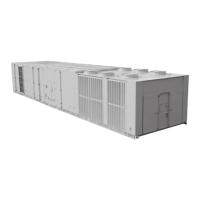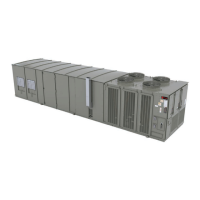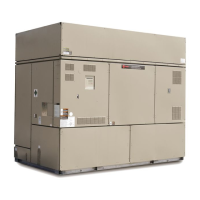RT-SVX073A-EN
175
Table 74. Air-cooled condenser—refrigerant coil fin data (continued)
Tons
Coil Type Coil Fin Config.
Tube Dia. Coil Rows
Fins per foot
Coil Face Area
(sq. ft.)
Tube Type
120
Evaporator Internally Finned
1/2 4 168 106.25
Internally Finned
Hi-Cap Evap Internally Finned
1/2 6 168 106.25
Internally Finned
Condenser Enhanced 25 mm 2 240 161 Microchannel
130
Evaporator Internally Finned
1/2 4 168 106.25
Internally Finned
Hi-Cap Evap Internally Finned
1/2 6 168 106.25
Internally Finned
Condenser Enhanced 25 mm 2 240 161 Microchannel
150
Evaporator Internally Finned
1/2 6 168 106.25
Internally Finned
Condenser Smooth 25 mm 2 240 161 Microchannel
Fan Belt Adjustment
The supply fan belts and optional exhaust fan belts must be
inspected periodically to assure proper unit operation.
Replacement is necessary if the belts appear frayed or
worn. Units with dual belts require a matched set of belts to
ensure equal belt length. When removing or installing new
belts, do not stretch them over the sheaves; instead,
loosen the adjustable motor-mounting base.
Once the new belts are installed, adjust the belt tension
using a Browning or Gates tension gauge (or equivalent)
illustrated in Figure 114, p. 175.
Figure 114. Typical belt tension gauge
Deflection = Belt Span (in.)
64
Deflection = Belt Span (mm)
152
Force Scale
Span Scale
Large
O-Ring
Small
O-Ring
Belt Span
WARNING
Hazardous Voltage w/Capacitors!
Failure to disconnect power and discharge capacitors
before servicing could result in death or serious
injury.
Disconnect all electric power, including remote
disconnects and discharge all motor start/run
capacitors before servicing. Follow proper lockout/
tagout procedures to ensure the power cannot be
inadvertently energized. For variable frequency drives
or other energy storing components provided by
Trane or others, refer to the appropriate
manufacturer’s literature for allowable waiting periods
for discharge of capacitors. Verify with a CAT III or IV
voltmeter rated per NFPA 70E that all capacitors have
discharged.
1. To determine the appropriate belt deflection:
a. Measure the center-to-center distance, in inches,
between the fan sheave and the motor sheave.
b. Divide the distance measured in Step 1a by 64; the
resulting value represents the amount of belt
deflection for the proper belt tension.
2. Set the large O-ring on the belt tension gauge at the
deflection value determined in Step 1b.
3. Set the small O-ring at zero on the force scale of the
gauge.
4. Place the large end of the gauge on the belt at the
center of the belt span. Depress the gauge plunger until
the large O-ring is even with the of the second belt or
even with a straightedge placed across the sheaves.
5. Remove the tension gauge from the belt. Notice that
the small O-ring now indicates a value other than zero
on the force scale. This value represents the force (in
pounds) required to deflect the belt(s) the proper
distance when properly adjusted.
6. Compare the force scale reading in step 5 with the
appropriate “force” value in . If the force reading is
outside of the listed range for the type of belts used,
either readjust the belt tension or contact a qualified
Service and Maintenance

